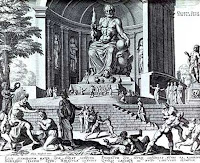Live Safe >> Get Insured:
Tuesday, May 29, 2007
The Seven Wonders of the World (or the Seven Wonders of the Ancient World) is a widely-known list of seven remarkable manmade constructions of classical antiquity. It was based on guide-books popular among Hellenic sight-seers and only includes works located around the Mediterranean rim. Later lists include those for the Medieval World and the Modern World.
The historian Herodotus and the scholar Callimachus of Cyrene (ca 305–240 BC) at the Museum of Alexandria, made early lists of "seven wonders" but their writings have not survived, except as references.
A later list, under various titles like De septem orbis spactaculis and traditionally misattributed to the engineer Philo of Byzantium, may date as late as the fifth century AD, though the author writes as if the Colossus of Rhodes were still standing.
These are given in the table below:
1. Wonder - Great Pyramid of Giza
Date Of Construction - 2650-2500 BC
Builders - Egyptians
Notable Features - Built as the tomb of Fourth dynasty Egyptian pharaoh Khufu.
Date Of Destruction - Still standing
Cause Of Destruction - Still standing

2. Wonder - Hanging Gardens of Babylon
Date Of Construction - 600 BC
Builders - Babylonians
Notable Features - Herodotus claimed the outer walls were 56 miles in length, 80 feet thick and 320 feet high (although some archaeological findings suggest otherwise).
Date Of Destruction - After 1st century BC
Cause Of Destruction - Earthquake

3. Wonder - Temple of Artemis at Ephesus
Date Of Construction - 550 BC
Builders - Lydians, Persians, Greeks
Notable Features - Dedicated to the Greek goddess Artemis, it took 120 years to build. Herostratus burned it down in an attempt to achieve lasting fame.
Date Of Destruction - 356 BC
Cause Of Destruction - Arson

4. Wonder - Statue of Zeus at Olympia
Date Of Construction - 435 BC
Builders - Greeks
Notable Features - Occupied the whole width of the aisle of the temple that was built to house it, and was 40 feet (12 meters) tall.
Date Of Destruction - 5th-6th centuries AD
Cause Of Destruction - Fire

5. Wonder - Mausoleum of Maussollos at Halicarnassus
Date Of Construction - 351 BC
Builders - Persians, Greeks
Notable Features - Stood approximately 45 meters (135 feet) tall with each of the four sides adorned with sculptural reliefs. Origin of the word mausoleum.
Date Of Destruction - by AD 1494
Cause Of Destruction - Earthquake

6. Wonder - Colossus of Rhodes
Date Of Construction - 292-280 BC
Builders - Hellenistic Greece
Notable Features - A giant statue of the Greek god Helios roughly the same size as today's Statue of Liberty in New York.
Date Of Destruction - 224 BC
Cause Of Destruction - Earthquake

7. Wonder - Lighthouse of Alexandria
Date Of Construction - 3rd century BC
Builders - Hellenistic Egypt
Notable Features - Between 115 and 135 metres (383 - 440 ft) tall it was among the tallest man-made structures on Earth for many centuries.
Date Of Destruction - AD 1303-1480
Cause Of Destruction - Earthquake

The Greek category was not "Wonders" but "theamata", which translates closer to "must-sees". The list that we know today was compiled in the Middle Ages—by which time many of the sites were no longer in existence. Since the list came mostly from ancient Greek writings, only sites that would have been known and visited by the ancient Greeks were included. Even as early as 1600 BC, tourist graffiti was scrawled on monuments in the Egyptian Valley of the Kings.
Antipater's original list replaced the Lighthouse of Alexandria with the Ishtar Gate. It wasn't until the 6th century AD that the list above was used. Of these wonders, the only one that has survived to the present day is the Great Pyramid of Giza. The existence of the Hanging Gardens has not been definitively proven. Records show that the other five wonders were destroyed by natural disasters. The Temple of Artemis and the Statue of Zeus were destroyed by fire, while the Lighthouse of Alexandria, Colossus, and Mausoleum of Maussollos were destroyed by earthquakes. There are sculptures from the Mausoleum of Maussollos and the Temple of Artemis in the British Museum in London.
Seven Wonders lists about the Middle Ages are existing historical lists for which there is no unanimity of opinion about origin, content or name. These historical lists go by names such as "Wonders of the Middle Ages" (implying no specific limitation to seven), "Seven Wonders of the Middle Ages", "Medieval Mind" and "Architectural Wonders of the Middle Ages". The lists are more properly seen as a continuing type or genre in the Seven Wonders tradition than a specific list.
It is unlikely the lists originated in the Middle Ages. Brewer's calls them "later list[s]" suggesting the lists were created after the Middle Ages. This is supported because the word medieval was not even invented until the Enlightenment-era, and the concept of a "Middle Age" did not become popular until the 16th century. Further, the Romanticism movement glorified all things related to the Middle Ages, or more specifically anything pre-Enlightenment era, suggesting such lists would have found a popular audience in the late 18th and early 19th centuries. Some items found on some of the lists are not technically from the Middle Ages (according to modern historical standards), but we know the lists were not created by modern medieval historians, so such standards did not apply.
Typically representative of the seven:
1.Stonehenge

Other sites that have been mentioned include:
1.Cairo Citadel










.jpg)
